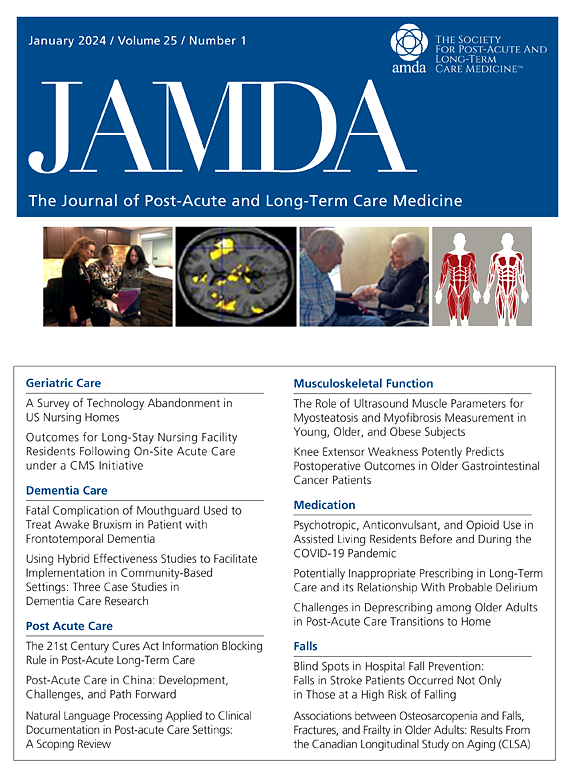Changing Oral Health Trajectories: A 10-Year Cross-Sectional Comparison of 2 Domiciliary Dental Care Patient Groups in Nursing Homes
IF 4.2
2区 医学
Q2 GERIATRICS & GERONTOLOGY
Journal of the American Medical Directors Association
Pub Date : 2025-02-11
DOI:10.1016/j.jamda.2024.105471
引用次数: 0
Abstract
Objectives
Since 2010, Gerodent has been a comprehensive oral health care program including biannual domiciliary dental care in nursing homes in Flanders, Belgium. Previous research revealed poor oral health among nursing home residents attending the mobile clinic. The objective of this study was to evaluate potential changes in the oral health needs of patients receiving domiciliary dental care, thus providing insights for future cohorts.
Design
This study compares the oral health status and treatment needs of 2 cross-sectional samples.
Setting and Participants
First-time patients attending the mobile dental clinic in nursing homes, collected a decade apart.
Methods
Generalized estimating equations were used to compare both samples [sample 1 (S1): 2010–2012: n = 1226; sample 2 (S2): 2021–2023: n = 775]. Results were adjusted for age, sex, increased reimbursement for health care costs, number of medications and care dependency. Differences in oral health outcomes were decomposed in a component attributed to the explanatory variables and an unexplained component using the Blinder–Oaxaca decomposition analysis.
Results
There were statistically significant lower edentulism rates in S2 (28%) than S1 [42%; odds ratio (OR), 1.82; 95% CI, 1.34–2.47]. Among dentate patients, S2 had a significantly lower caries prevalence (S1: 70% vs S2: 53%; OR, 0.55; 95% CI, 0.44–0.69) and a significantly higher mean of filled teeth (S1: 1.5 vs S2: 2.8; rate ratio, 1.82; 95% CI, 1.58–2.09). In the dentate sample, 77% of S1 and 54% of S2 residents required extractions and/or restorations (OR, 0.72; 95% CI, 0.53–0.98). The decomposition analysis showed that the change in explanatory variables attributed little to the shift in dental status. The explained component accounted for only 13.5% of the total risk difference in edentulism (bias-corrected and accelerated 95% CI, −0.6% to 30.6%).
Conclusion and Implications
From 2021 to 2023, more dentate care home residents consulted Gerodent with more natural teeth per person, showing lower levels of untreated disease, maintaining dental team treatment demands comparable with 2010–2012. These findings underscore the continued urgency for structured and accessible dental service provision for nursing home residents.
口腔健康轨迹的改变:疗养院2个住家牙科护理患者组的10年横断面比较。
目标:自2010年以来,Gerodent一直是一个全面的口腔保健计划,包括每年两次在比利时佛兰德斯的养老院进行的牙科护理。先前的研究显示,到流动诊所就诊的养老院居民口腔健康状况不佳。本研究的目的是评估接受居家牙科护理的患者口腔健康需求的潜在变化,从而为未来的队列提供见解。设计:本研究比较2个横断面样本的口腔健康状况和治疗需求。环境和参与者:首次到养老院流动牙科诊所就诊的患者,收集时间间隔为十年。方法:采用广义估计方程对两个样本进行比较(样本1 [S1]: 2010-2012: n = 1226;样本2 [S2]: 2021-2023: n = 775)。结果根据年龄、性别、医疗费用报销增加、药物数量和护理依赖程度进行了调整。使用Blinder-Oaxaca分解分析,将口腔健康结果的差异分解为归因于解释变量的成分和未解释的成分。结果:S2组的全牙率(28%)低于S1组(42%);优势比[OR], 1.82;95% ci, 1.34-2.47)。在有齿患者中,S2的龋患病率明显较低(S1: 70% vs S2: 53%;或者,0.55;95% CI, 0.44-0.69),且平均补牙率明显较高(S1: 1.5 vs S2: 2.8;风险比,1.82;95% ci, 1.58-2.09)。在齿状样本中,77%的S1居民和54%的S2居民需要拔牙和/或修复(or, 0.72;95% ci, 0.53-0.98)。分解分析表明,解释变量的变化与牙齿状况的变化关系不大。可解释的因素仅占全牙症总风险差异的13.5%(偏差校正和加速95% CI, -0.6%至30.6%)。结论与意义:2021 - 2023年,更多的牙科护理之家居民以更多的人均天然牙咨询洁登特,显示出较低的未治疗疾病水平,与2010-2012年保持相当的牙科团队治疗需求。这些发现强调了为养老院居民提供结构化和可访问的牙科服务的持续紧迫性。
本文章由计算机程序翻译,如有差异,请以英文原文为准。
求助全文
约1分钟内获得全文
求助全文
来源期刊
CiteScore
11.10
自引率
6.60%
发文量
472
审稿时长
44 days
期刊介绍:
JAMDA, the official journal of AMDA - The Society for Post-Acute and Long-Term Care Medicine, is a leading peer-reviewed publication that offers practical information and research geared towards healthcare professionals in the post-acute and long-term care fields. It is also a valuable resource for policy-makers, organizational leaders, educators, and advocates.
The journal provides essential information for various healthcare professionals such as medical directors, attending physicians, nurses, consultant pharmacists, geriatric psychiatrists, nurse practitioners, physician assistants, physical and occupational therapists, social workers, and others involved in providing, overseeing, and promoting quality

 求助内容:
求助内容: 应助结果提醒方式:
应助结果提醒方式:


